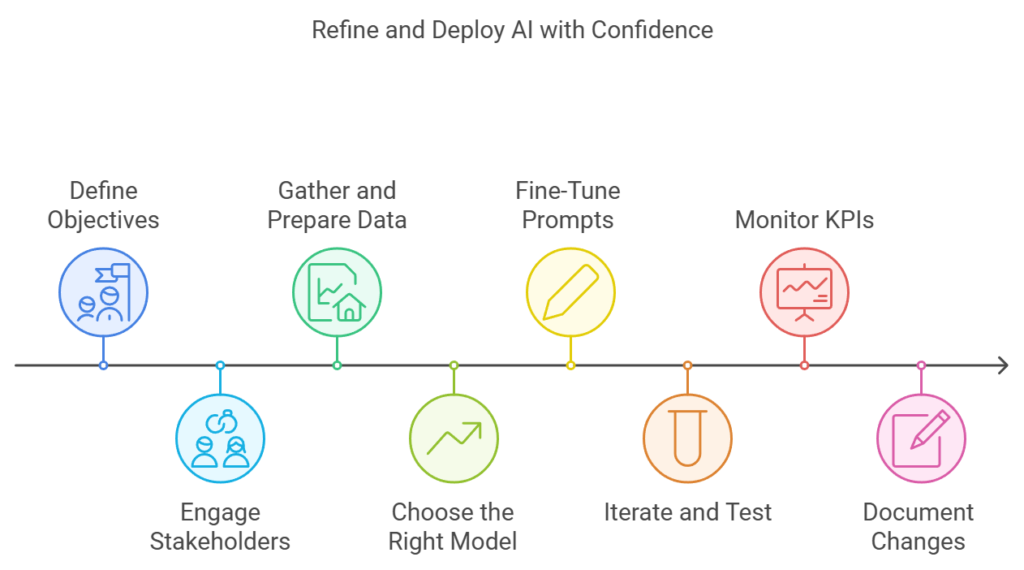In the world of AI, deploying a system often feels like a journey without a clear endpoint. Much like Sisyphus rolling a boulder uphill, you make progress, only to encounter new challenges that send you back to the drawing board. The initial excitement of getting your AI model up and running can quickly be tempered by the reality of constant refinement, adjustment, and improvement.
But there’s a silver lining: this iterative process is not a punishment, but rather the key to success. Each adjustment is an opportunity to fine-tune your system and better align it with your goals. The trick lies in embracing the continuous learning cycle and taking a structured approach to model refinement.
Embracing the Iterative Nature of AI
AI isn’t a “set it and forget it” solution. It’s a system that requires ongoing calibration to stay effective. What works today might not work tomorrow as new data emerges or business needs evolve. This iterative process can be frustrating, but it’s also fundamental to the very nature of AI—after all, a system that learns must continuously adapt.
The real challenge comes in managing these adjustments. It’s tempting to think that more data or constant tweaking will yield better results, but indiscriminate changes can actually disrupt your system’s balance. Instead, you need a clear, methodical approach to navigating these iterations.
Common Misconceptions in AI Deployments
Before diving into strategies for successful AI refinement, let’s address a few common misconceptions:
- More Data is Always Better: While data is the lifeblood of AI, it’s the quality, not just the quantity, that matters. Without well-structured, relevant data, you risk confusing your model, much like rolling Sisyphus’ boulder up a random path only to lose direction.
- AI Can Fully Replace Human Input: AI enhances human capabilities, but it doesn’t replace them. Human oversight is critical for interpreting outputs and making complex decisions. Viewing AI as a partner rather than a replacement prevents feelings of isolation or overwhelm.
- AI is a One-Time Setup: AI systems require continuous updates and monitoring. Assuming otherwise can lead to disillusionment. Think of AI as a tool that, much like the boulder, requires persistent effort and attention to keep it moving forward.
- AI is Only for Big, Tech-Savvy Companies: The perception that AI is inaccessible to smaller organizations is outdated. Today, user-friendly tools and resources make AI available to companies of all sizes. Success in AI deployment is more about strategy than scale.

A Structured Approach to AI Deployment Refinement
Here’s a structured, step-by-step guide to refining AI deployments and turning challenges into opportunities.

1. Setting the Foundation
Define Your Objectives
The first step in any successful AI project is clarity. What do you want to achieve? Define your objectives clearly, ensuring they align with your organization’s broader goals. Examples might include:
- “Reduce customer response times by 50% through AI chatbots, allowing human agents to focus on more complex inquiries.”
- “Increase the accuracy of sales forecasts by 30%, optimizing inventory management and cutting holding costs by 15%.”
These specific, measurable goals provide a benchmark for success and help you stay focused.
Engage Stakeholders
AI deployment affects multiple stakeholders, from end users to IT teams. Engaging these groups early on ensures that the system meets their needs and fosters a sense of collaboration. It also provides valuable feedback that can guide early refinements.
2. Data Preparation and Model Selection
Gather and Prepare Your Data
High-quality data is the cornerstone of AI success. Ensure that your data is clean, well-structured, and relevant to the task at hand. More isn’t always better—curating your dataset for accuracy and relevance will yield better results than simply adding more information.
Choose the Right Model
The AI model you choose should fit your specific objectives. Whether it’s a machine learning algorithm, natural language processing (NLP) model, or something else, aligning the model type with your goal and data type is crucial. Avoid the temptation to use the most complex model available when a simpler solution might do.

3. Implementation and Iteration
Fine-Tune Your Prompts
In many AI systems, especially those driven by NLP, the way you phrase your inputs (prompts) can have a huge impact on the results. Experiment with different structures and approaches to see what works best. Prompt engineering is an art that often requires iteration to get right.
Iterate and Test
Deploy a Minimum Viable Product (MVP) and test it in real-world scenarios. Real-world feedback is invaluable—it will reveal gaps, uncover unforeseen issues, and guide further improvements. Use this feedback to refine the model incrementally, embracing continuous improvement.
4. Monitoring and Documentation
Monitor Key Performance Metrics
Track key performance indicators (KPIs) that directly relate to your goals. Whether it’s accuracy, speed, or user satisfaction, monitoring these metrics allows you to assess the effectiveness of your AI system and make informed adjustments.
Document Changes and Learnings
Keeping a detailed log of the changes you make, along with the results, can prevent you from repeating mistakes and offer insights for future projects. Documentation also provides a reference for others working on the same or similar projects, building institutional knowledge.
5. Agility and Scaling
Stay Agile
The world of AI evolves rapidly, and staying informed about new techniques, models, and tools is essential. Agility will ensure your system stays relevant and competitive. Don’t hesitate to pivot when new developments offer better solutions.
Review and Scale
Once your system is refined and stable, think about scaling it. What worked in the pilot phase? What needs to be adjusted to handle larger datasets or more complex use cases? Successful scaling requires thoughtful adjustments based on real-world performance, not just increasing capacity.
Conclusion
The AI journey is one of continuous improvement, but it’s far from Sisyphean. While you may face setbacks and frustrations along the way, every adjustment brings you closer to a well-oiled, high-performing system. By taking a strategic approach, staying agile, and learning from each iteration, you can overcome the challenges and unlock the full potential of AI for your organization.
The boulder may roll back at times, but each push takes you further along the path. Embrace the process, and know that with perseverance and strategic action, the summit is within reach.

